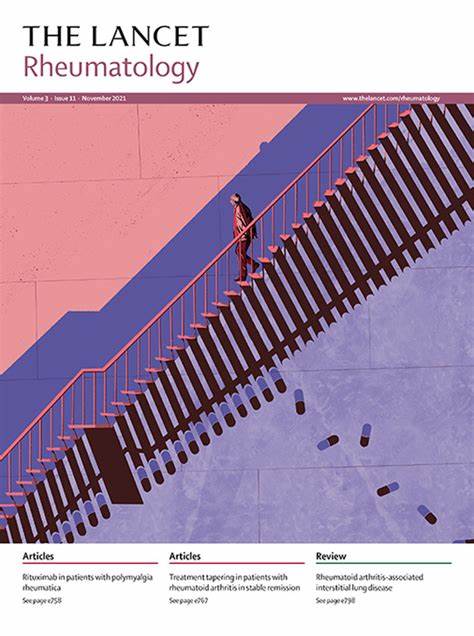美国马萨诸塞州及周边地区历史上的红线和当今种族经济隔离与风湿病患者使用医疗服务的关系:一项回顾性队列研究。
IF 15
1区 医学
Q1 RHEUMATOLOGY
引用次数: 0
摘要
背景:结构性种族主义是不公平的根源,但它对风湿病护理的影响却未得到充分研究。红线是美国联邦政府发起的一种做法,它将黑人和移民居民高度集中的地区划为投资危险区。我们的目的是调查历史上的redlining和当今的种族经济隔离对美国马萨诸塞州及周边地区风湿病患者的医疗保健利用率的影响:这项回顾性观察队列研究利用麻省综合医院布里格姆研究中心病人数据登记处的多医院数据,对居住在马萨诸塞州及周边地区、年龄≥ 18 岁、有两个或两个以上风湿病国际疾病分类代码的人进行识别。在 2000 年 1 月 1 日至 2023 年 5 月 1 日期间,在马萨诸塞州布里格姆综合医院(波士顿,马萨诸塞州,美国)附属风湿病诊所接受过治疗的患者均被纳入其中。地址已进行地理编码,并与 1930 年代房屋所有者贷款公司 (HOLC) 的红线文件进行了叠加。根据美国人口普查数据构建了综合种族和收入两极分化的极端集中指数(ICE)。我们使用多层次、多项式逻辑回归模型,按历史 HOLC 等级(A [最佳] 至 D [危险])和 ICE 五分位数(最贫困 [1] 至最优越 [5] 种族和收入)分别研究了使用医疗服务的几率,并对人口统计学、保险和合并症进行了调整。有风湿病生活经历的人没有参与本研究的设计和实施:组群由 5597 人组成;5597 名患者中有 3944 人(70-5%)为女性,1653 人(29-5%)为男性,657 人(11-7%)为黑人,224 人(4-0%)为西班牙裔,年龄中位数为 63(50-73)岁。5597 人中有 1295 人(23-1%)生活在历史上最贫困的地区(HOLC D),1780 人(31-8%)生活在当今种族经济贫困最集中的地区(ICE 五分法 1)。与居住在最理想社区(HOLC A)的人相比,居住在历史上曾被划为红线的地区(HOLC D)的人有更大的几率错过四次或四次以上的预约(几率比 [OR] 1-78 [95% CI 1-21-2-61]; p=0-0033)和三次或三次以上的急诊就诊(2-69 [1-48-4-89]; p=0-0011)。在种族和经济高度集中的贫困地区(ICE 五分法 1),个人四次或四次以上失约的几率更大(OR 2-11 [95% CI 1-65-2-71];p解释:历史上的 "红线 "可能是当今医疗保健使用模式不平等的结构性决定因素。消除结构性种族主义的政策干预措施可以减少风湿病患者在获得医疗服务方面的不平等:布里斯托尔-迈尔斯-施贵宝基金会。本文章由计算机程序翻译,如有差异,请以英文原文为准。
Association of historical redlining and present-day racialised economic segregation with health-care utilisation among individuals with rheumatic conditions in Massachusetts and surrounding areas of the USA: a retrospective cohort study
Background
Structural racism lies at the root of inequities; however its impact on rheumatology care is understudied. Redlining was a US federal government-sponsored practice that mapped areas with high concentrations of Black and immigrant residents as hazardous for investment. We aimed to investigate the association of historical redlining and present-day racialised economic segregation, on health-care utilisation among individuals with rheumatic conditions in the US state of Massachusetts and surrounding areas.
Methods
This retrospective observational cohort study used multihospital data from the Mass General Brigham Research Patient Data Registry to identify individuals aged ≥ 18 years living in Massachusetts and surrounding areas, with two or more International Classification of Diseases codes for a rheumatic condition. Individuals were included if they received care between Jan 1, 2000, and May 1, 2023, at rheumatology practices affiliated with Mass General Brigham (Boston, MA, USA). Addresses were geocoded and overlaid with 1930s Home Owners' Loan Corporation (HOLC) redlining files. The Index of Concentration at the Extremes (ICE) for combined racial and income polarisation was constructed from US Census data. We used multilevel, multinomial logistic regression models to examine the odds of health-care utilisation separately by historical HOLC grade (A [best] to D [hazardous]) and ICE quintile (most deprived [1] to most privileged [5] race and income), adjusting for demographics, insurance, and comorbidities. People with lived experience of a rheumatic condition were not involved in the design or implementation of this study.
Findings
The cohort comprised 5597 individuals; 3944 (70·5%) of 5597 patients were female, 1653 (29·5%) were male, 657 (11·7%) were Black, 224 (4·0%) were Hispanic, and the median age was 63 (50–73) years. 1295 (23·1%) of 5597 individuals lived in the most historically redlined areas (HOLC D) and 1780 (31·8%) lived in areas with the most concentrated present-day racialised economic deprivation (ICE quintile 1). Individuals in historically redlined areas (HOLC D) had greater odds of having four or more missed appointments (odds ratio [OR] 1·78 [95% CI 1·21–2·61]; p=0·0033) and of three or more emergency department visits (2·69 [1·48–4·89]; p=0·0011) compared with those in the most desirable neighbourhoods (HOLC A). Individuals in areas with highly concentrated racial and economic deprivation (ICE quintile 1) had greater odds of four or more missed appointments (OR 2·11 [95% CI 1·65–2·71]; p<0·0001) and of three or more emergency department visits (2·97 [2·02–4·35]; p<0·0001) versus those in areas with highly concentrated privilege (ICE quintile 5).
Interpretation
Historical redlining could be a structural determinant of inequities in present-day health-care utilisation patterns. Policy interventions that dismantle structural racism could reduce inequities in access to care for individuals with rheumatic conditions.
Funding
Bristol Myers Squibb Foundation.
求助全文
通过发布文献求助,成功后即可免费获取论文全文。
去求助
来源期刊

Lancet Rheumatology
RHEUMATOLOGY-
CiteScore
34.70
自引率
3.10%
发文量
279
期刊介绍:
The Lancet Rheumatology, an independent journal, is dedicated to publishing content relevant to rheumatology specialists worldwide. It focuses on studies that advance clinical practice, challenge existing norms, and advocate for changes in health policy. The journal covers clinical research, particularly clinical trials, expert reviews, and thought-provoking commentary on the diagnosis, classification, management, and prevention of rheumatic diseases, including arthritis, musculoskeletal disorders, connective tissue diseases, and immune system disorders. Additionally, it publishes high-quality translational studies supported by robust clinical data, prioritizing those that identify potential new therapeutic targets, advance precision medicine efforts, or directly contribute to future clinical trials.
With its strong clinical orientation, The Lancet Rheumatology serves as an independent voice for the rheumatology community, advocating strongly for the enhancement of patients' lives affected by rheumatic diseases worldwide.
 求助内容:
求助内容: 应助结果提醒方式:
应助结果提醒方式:


